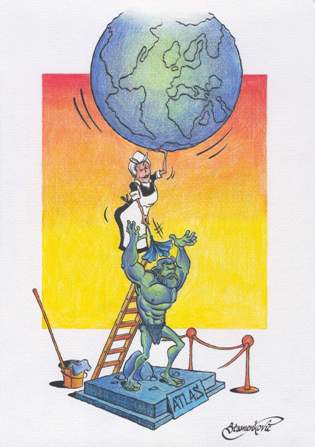Does environmental destruction politicize women?
Curator Masum Momaya introduces “Environment”
Why is it that most recent conversations about the "planet in peril," including deforestation, climate change, natural disasters and changing water levels, rarely reference women? Women are disproportionately impacted by changes in the environment. And, with indigenous knowledges in tow and generations of experience working the land, gathering wood and fetching water, women bring unique, effective and sustainable solutions to environmental problems. Moreover, activism on behalf of the environment has allowed women to step up into positions of power, receiving political training and organizing experience that catapult them into influential roles.
In 1962, scientist Rachel Carson's publication of Silent Spring extolled the detrimental effects of pesticides on the environment. Thus began a movement to connect social conditions and practices with environmental devastation. In this movement, it would eventually come to be understood that, due to gender roles and worldwide inequality between women and men, women are unduly burdened when the earth is destroyed.
When the Environment is Harmed, Women Hurt
In most families, women are responsible for growing, gathering, trading, buying and preparing food. The destruction of local crops, the wearing out of soil by corporate farming techniques, the increased expense of seed, fertilizer and water and the politics of food distribution in corrupt and war-torn countries leave many women scrambling to feed their families.
Women are also responsible for fetching water. Some women walk many kilometers each day to bring home this precious resource, carrying on it their heads in large, heavy containers. Changing water levels, contamination of fresh water sources and privatization of water management and distribution services have left families and communities without water for washing, laundry and cooking.
Similarly, women are often the primary gatherers of firewood for cooking and heating fuel. Centuries of deforestation in many places in the world have stripped forests bare, leading women to find alternative energy sources and plant trees.
In the last few decades, research has shown that environmental toxins have led to increases in breast and ovarian cancers. Many women who live in high exposure areas don't have means to relocate and are disenfranchised from their local political systems.
Finally, a look at natural disasters over the last ten years has shown that women suffer the most. Often left without shelter, spouses and savings, women are displaced and vulnerable to violence.
Women Bring Unique Solutions to Environmental Problems
In the wake of all this devastation, though, women are resilient. In many communities, indigenous knowledge about seeds and biodiversity , passed down through generations of women, allow women to preserve the environment while adapting to its changes.
Environmental Activism Brings out the Power in Women
At the very least, environmental activism has allowed women to "cut their teeth" as organizers and advocates , gaining political experience for local and national campaigns. For example, Wangari Maathai, founder of Kenya's Green Belt movement, drew upon the experience she gained by organizing rural women to plant trees to eventually influencing military and security policy and run for president in her own country.
Political parties, such as the Green Party, which run on a social justice platform that includes environmental sustainability, are eager to embrace women and their knowledge. In the wake of so much devastation and despair, the environment politicizes women.
Explore all the stories in this theme.


